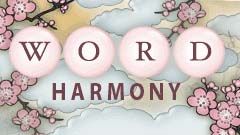Retro Replay Review
Gameplay
Word Harmony’s gameplay centers on manipulating physically simulated “letter balls” that roll, bounce, and collide within beautifully designed arenas. In Puzzle mode, you’re presented with a list of target words and an intricate set of obstacles—ramps, walls, and portals—that you must navigate to guide each letter ball to its correct position. The tactile feel of nudging a ball into place adds an engaging layer of spatial reasoning on top of the word-forming challenge.
(HEY YOU!! We hope you enjoy! We try not to run ads. So basically, this is a very expensive hobby running this site. Please consider joining us for updates, forums, and more. Network w/ us to make some cash or friends while retro gaming, and you can win some free retro games for posting. Okay, carry on 👍)
Switch to Tsunami mode, and the pace picks up drastically. Letters continuously drop into a serene pool, and you have only moments to form words before the water level rises too high. Fast reflexes and quick pattern recognition are key; the physics engine makes each drop unpredictable, so you can’t rely on rote memorization. This mode delivers a satisfying adrenaline rush for players who enjoy real-time thrills paired with linguistic skill.
Think mode offers the most contemplative challenge: you’re given a fixed set of letters and tasked with creating words that use every single character exactly once. There’s no time pressure, but the mental gymnastics required to find the perfectly exhaustive set of words can be as intense as any timed trial. It’s the ideal mode for players who prefer deep focus and cerebral puzzles over reflex-driven action.
Across all modes, the integration of physics and wordplay strikes a unique balance. Beginners can dip their toes into casual Puzzle stages, while veterans will find mastery arcs in Think and the fast-paced pressure cooker of Tsunami. Each mode feels distinct yet unified by the core mechanic of guiding letter balls to their destinations.
Graphics
The visual presentation in Word Harmony is a standout feature, inspired by traditional Japanese art. Delicate brushstroke textures adorn the game’s backgrounds, evoking ink wash paintings, while minimalist UI elements keep the screen free of clutter. The result is a tranquil aesthetic that soothes the mind even as you tackle complex puzzles.
The letter balls themselves are rendered with realistic physics-based motion, complete with subtle shadows and reflections on the pool’s surface in Tsunami mode. Watching them roll and collide feels almost meditative, reinforcing the game’s theme of harmonious balance. Special effects—such as ripples in the water or the soft glow when a word is completed—add delight without ever overwhelming the senses.
Each mode boasts its own palette: Puzzle mode often features warm, earthen tones; Tsunami mode shifts to cool blues and aquamarines; Think mode leans into neutral grays with hints of gold. These color choices not only differentiate the modes at a glance but also subtly influence your mood—encouraging calm focus or brisk excitement where appropriate.
Story
While Word Harmony doesn’t follow a traditional narrative with characters and cutscenes, it does weave a thematic tale of balance and simplicity. Each stage can be viewed as a zen garden, offering a moment of quiet reflection punctuated by the satisfying click of letters forming words. The absence of a heavy storyline allows the gameplay and aesthetics to shine without distraction.
The game’s progression is framed as a journey through different spiritual landscapes: bamboo groves, koi ponds, and temple courtyards. Though you won’t meet NPCs or experience dramatic plot twists, these settings evoke a sense of exploration. Every completed level feels like a small pilgrimage toward clarity and mastery.
Subtle audio cues—wind chimes, soft drumbeats, and distant temple bells—further the illusion of a guided meditation. They suggest a narrative of personal growth: as you learn to manipulate the letter balls with precision, you also cultivate patience and linguistic dexterity. The story here is internal, felt in your gradual improvement and deepening appreciation for the artful presentation.
Overall Experience
Word Harmony successfully marries cerebral word puzzles with physics-based gameplay and a serene Japanese art style. It’s a rare combination that offers both mental challenge and sensory relaxation. Whether you’re racing against the tide of letters in Tsunami or leisurely crafting perfect word sets in Think mode, each session feels fresh and engaging.
The learning curve is gentle at first, thanks to straightforward Puzzle levels that teach you the controls and physics behavior. As you advance, the difficulty ramps up in thoughtful increments, ensuring you’re always challenged but never overwhelmed. The three distinct modes provide variety, so you can switch gears whenever you need a change of pace.
Word Harmony is an ideal purchase for word game enthusiasts seeking something beyond the typical crossword or anagram app. Its emphasis on physicality and atmosphere makes it stand out in a crowded genre. If you appreciate games that double as digital meditations—where solving puzzles feels like practicing zen—this title offers hours of satisfying gameplay and stunning visuals.
For casual players, the game can be enjoyed in short bursts, while completionists will find plenty of optional challenges to master. With its polished presentation and inventive mechanics, Word Harmony is a must-consider for anyone who values both brain-teasing fun and artistic beauty in their gaming library.
 Retro Replay Retro Replay gaming reviews, news, emulation, geek stuff and more!
Retro Replay Retro Replay gaming reviews, news, emulation, geek stuff and more!




Reviews
There are no reviews yet.